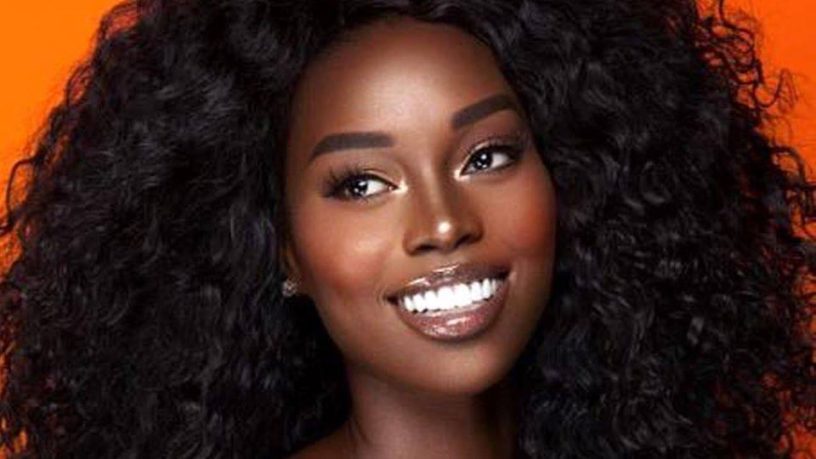 by Alagi Yorro Jallow.
by Alagi Yorro Jallow.
Mamudu: Sene-Gambia needs to withdraw from every obligation in Africa and focus on a single and exclusive priority: declare a state of emergency on the issue of female skin bleaching. The Gambia and Senegal gave us Africa’s most famous celebration of the African female form and color in Senghor’s poem, “Black Woman”. I’ve seen skin bleaching in African capitals, but Banjul and Dakar are in a world and class of its own.
As if God wants to mock women yonder, He tends to make African humanity in that area several shades of darker beautiful ebony than the rest of us. This means that the road to mass, epidemic female whiteness is even much more visually galling. Black beauty in Fatoumatta. Now I see her in all the black is gone. She is entirely white! Fatoumatta, too has joined the bleaching train. Another tragic loss to the fragile and endangered population of Black women in Senegambia.
Whenever a black woman bleaches and becomes white, I mourn her demise in blackness, but I don’t know whether to rejoice with her on her birth into whiteness. Black is on its way to extinction in Senegambia. I’ve been complaining and whining and grumbling about this issue here. In the rest of the Gambia, bleaching is a problem. In Senegambia, it is a pandemic. What do you do about a cultural industry in a mad rush for whiteness? What do you do about a media industry that has declared war on melanin?
Mamudu: I have even started to notice two categories of bleached female journalists. Those with sufficient taste and means to uniformly and smoothly peel off everything and become honorary white people. You suspect they went to America or Las Palmas de Gran Canaria for the peeling and have a substantial investment in bleaching maintenance creams.
Mamudu: Then some carried out their bleaching in local “saabo soda,” locally made Aesop soap, using local acid soap and creams. They are mongrels – a terrible mix of white and black body parts, almost like leopards with black spots. You have white areas of the skin struggling to illuminate poorly-lit areas like pitch-black knuckles, pitch-black elbows, pitch-black knees, etc.
Mamudu: And the male folks, the Fellas too are in this mad rush for whiteness, also divided into two classes of bleachers.
I find it really painful that Fatoumatta is now white. Her transformation happened recently. She was still a gorgeous black woman in her high school days and her early media career.
“Black Woman
– Leopold Senghor
Naked woman, black woman
Clothed with your color which is life,
with your form, which is beauty!
In your shadow I have grown up; the
gentleness of your hands was laid over my eyes.
And now, high up on the sun-baked
pass, at the heart of summer, at the heart of noon,
I come upon you, my Promised Land,
And your beauty strikes me to the heart
like the flash of an eagle.
Naked woman, dark woman
Firm-fleshed ripe fruit, sombre raptures
of black wine, mouth making lyrical my mouth
Savannah stretching to clear horizons,
savannah shuddering beneath the East Wind’s
eager caresses
Carved tom-tom, taut tom-tom, muttering
under the Conqueror’s fingers
Your solemn contralto voice is the
spiritual song of the Beloved.
Naked woman, dark woman
Oil that no breath ruffles, calm oil on the
athlete’s flanks, on the sides of the Princes of Mali
Gazelle limbed in Paradise, pearls are stars on the
night of your skin
Delights of the mind, the glinting of red
gold against your watered skin
Under the shadow of your hair, my care
is lightened by the neighboring suns of your eyes.
Naked woman, black woman,
I sing your beauty that passes, the form
that I fix in the Eternal,
Before jealous fate turn you to ashes to
feed the roots of life”.
The poem “Black Woman” was written by Leopold Senghor and published in “Chants d’Ombre” in 1945. It was initially written in French as “Femme Noir” and then translated to English. Senghor was a Senegalese poet who was instrumental in starting the emotional, intellectual, and political and literary movement called “negritude” along with other writers of African origin- like Aime Cesaire- in Paris. This movement was born as a result of Senghor going to Paris to study in 1928.
“Black Woman” is one of the best-known poems from this collection. When Senghor writes of Africa, it is frequently in terms of a woman, a woman who is both wife and mother; she is the “promised land” mentioned in the poem.
The first stanza gives the theme of the poem: the natural black woman whose color is life and whose form is beauty. The poet has grown up in her shadow and has felt the gentleness of her hands. Now that he is grown, he returns to find her as if he were coming upon the promised land. He views her through a mountain pass at noon amid summer, and her beauty strikes him directly to the heart, like the flash of an eagle.
In the second stanza, she is seen as a lover, a woman with the flesh of ripe fruit, a woman who can transport the poet with somber ecstasies of black wine, a woman with a mouth that makes his own mouth lyric. The poet elaborates, finding her a woman who is like a limitless savanna that shudders beneath the caresses of the east wind; a woman who is like a tight, well-sculpted drum that resounds under the fingers of the Conqueror; a woman whose solemn contralto voice becomes the spiritual song of the loved one.
In the third stanza, she is almost a goddess, so perfect that even her skin is smooth as the oiled skin of an athlete or a prince. She is like a graceful gazelle with celestial adornments. Pearls become stars on the darkness of her skin. The reflections of the setting sun on her glistening skin are delights on which the mind can exercise itself. The poet’s anguish is lightened by the sunlike glance from her eyes when he is in the shadow of her hair.
In the fourth and last stanza, the poet—more philosophical—informs the black woman that he is celebrating in verse her beauty, which is passing, and her form, which he establishes eternally in his poetry before fate can turn her to ashes to nourish the roots of life.
Fashion and Style, News, Opinion
Alagie Yorro Jallow: “Black Is Beauty “






Ma sha Allah great and thanks for sharing